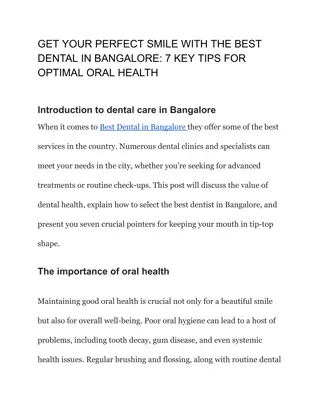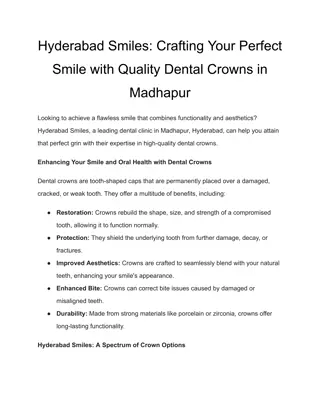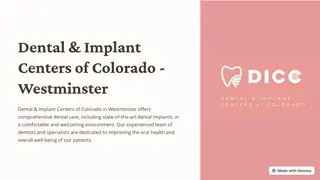Dental Health for Specially-Needed Populations
Dental health for individuals with disabilities and medical compromises requires special care and attention. The challenges in delivering dental care, issues faced, and key steps to ensure proper treatment are discussed. Understanding disabilities, types of disabilities, oral health status, and the importance of preventive care are emphasized. Addressing concerns like consent, funding limitations, and normalization in dental services is crucial for improving access and quality of care for disabled individuals.
Download Presentation

Please find below an Image/Link to download the presentation.
The content on the website is provided AS IS for your information and personal use only. It may not be sold, licensed, or shared on other websites without obtaining consent from the author.If you encounter any issues during the download, it is possible that the publisher has removed the file from their server.
You are allowed to download the files provided on this website for personal or commercial use, subject to the condition that they are used lawfully. All files are the property of their respective owners.
The content on the website is provided AS IS for your information and personal use only. It may not be sold, licensed, or shared on other websites without obtaining consent from the author.
E N D
Presentation Transcript
Dental health for specially needed population Dr. Rihab Abdul Hussein Ali B.D.S , M.Sc. , PhD.
Dental health of disabled and medically compromised child
Disability: It refers to any restriction or lack of ability to perform an activity. A disabled individual is a person who has one or more physical, medical, mental, or emotional problems that result in a limitation of the ability to function normally in fulfilling the activities of daily living (ADLs). Disability includes all handicapping conditions or combinations and could be developmental in origin or acquired.
Classification of disabling conditions: Physical disability such as cerebral palsy. Mental disability such as Down syndrome and mental retardation. Sensory disability like deafness and blindness. Medical compromise disability like diabetes and Acquired Immune Deficiency Syndrome (AIDS).
Oral health status: Oral health may show differences between normal and disabled people. It had been found that disabled individuals have tended to have more teeth missing, more untreated decay and fewer teeth restored. Dental care is often generated as an emergency. With few exceptions, preventive care has not been emphasized in the way as it should. The two most important oral health problems among disabled patients are dental caries and periodontal disease.
The issues regarding the delivery of care to people with disabilities: Normalization. Lack of funding for training in the Community Dental Service. Cost of specialist services and facilities. Unwillingness of some general dental practitioners to provide dental services to some groups in the community. Consent and restraint.
It is important for dental providers to follow a few simple steps when treating these patients: Medical, dental and health history should be assessed. Vital signs should be taken. Communicate clearly with a patient who is able to do so. Otherwise, refer questions to the person s caregiver. Obtain consent for treatment and possible medical stabilization. Assess the patient for possible complications during dental treatment and utilization of medical stabilization if necessary.
If medical stabilization is needed, document clearly the time patient utilized medical stabilization and the purpose for which it was utilized. Document the patient s tolerance for procedures. Note any complications during treatment. Document the procedures performed and those needed in future appointments. Sign your name and professional title.
Dental management and preventive measures among disabled individuals: There are general ways to promote the oral health of people with disabilities before consideration of specific techniques and modalities of dental care. They include: To have an advocate someone to ensure that the individuals concerned receive the care they need if they are not in a position to demand it themselves. This relies on caregivers being aware of potential needs. Ensuring that financial barriers to dental care are removed is vital. Services themselves need to be offered flexibly. People with limitations of movement needs safe and effective positioning and may extend to the use of conscious sedation or even general anesthesia as an adjunct to care.
The risk factors for dental caries among disabled individuals include: Dietaryconstituents and form. Liquid oral medicines. Poor oral clearance/stagnation. Resistance to mouth cleaning. Infrequent attendance. Attitude of caregivers.
Preventive and treatment services should evident to maintain oral health at higher level by: Application of topical fluoride for those who may be at higher risk for the development of carious lesion. Administration of such agents can be difficult in a severelyintellectually impaired person. Conventional dental treatment may not be appropriate for all patients. For some groups, the only way is with the aid of general anesthesia. For other patients, an alternative approach to managing carious lesion using simple a traumatic restorative technique (ART).
Dietary consideration for people with disabilities may need to be different. For severely impaired people, food is often liquidized or fed in semi-solid state after mashing. Some very disabled children and adults need to take high calorie supplements in order to maintain nutritional status. A proper diet is essential for a good preventive program for disabled child, to reduce the cariogenic potential, so it is necessary: to restrict between meal snacking. Limit use of highly cariogenic food. Liquid oral medicines taken can be damaging for the dentition especially in chronic users, a regular mouth cleaning using fluoride toothpaste is recommended. If the patient will not tolerate the use of the toothpaste, then a toothbrush dipped in fluoride mouthwash (0.2% sodium fluoride) as a part of the mouth cleaning routine.
People with physical (neurological) impairment: 1. Periodontal diseases and caries are both more widespread in cerebral palsy (CP). Enamel hypoplasia, mouth breathing, and food retention in the mouth all contribute to the increased rates of periodontal disease and caries. Physical constraints of the patient with CP can make proper oral hygiene difficult. For these reasons, the patient or caregiver should use A unique, individualized dental care plan. In a person who can not tolerate extensive, rehabilitative dental care then it may be necessary to remove badly worn and sensitive teeth.
Pureed diets are recommended for cerebral palsy patients who have difficulty in swallowing. For patients who have difficulty grasping a conventional, slim-handled brush, manual toothbrush with an enlarged handle, elastic cuff can be used caregiver-directed plaque control measures. Electric toothbrushes are not recommended for those severely disabled individuals due to their increased weight, difficulty in using on/off switch as well as these devices can cause considerable damage to the hard and soft tissue in a short time.
2. Several cases of gingival hyperplasia can be seen among those disabled individuals. 3. The malocclusion is due to skeletal problems and the common habit of tongue thrusting, and bruxism due to increased rate of temporomandibular joint (TMJ) disorder. Severe bruxism can cause wear of tooth, tooth fractures, and possibly pulpal exposure of teeth. If reasonable for the individual, orthodontics could be considered. A mouth guard could help reduce the effects of the prolonged clenching. 4. Patients with cerebral palsy also tend to have hyperactive bite and gag reflexes. If the gag reflex becomes a problem for the dental provider, keeping the patient in a semi upright position with chin down. Immobilization of uncooperative physically disabled patients need papoose board for stabilization of body, adjustment of head by head positioner, and strap and tape for extremities.
Visual Deficits: It may range from correctable deficiencies to total blindness. Chair side instructions of tooth brushing and flossing should be demonstrated on: Oversized models of the dentition with a giant-sized toothbrush. Red floss can help when demonstrating flossing to those with visual impairment who have difficulty seeing white floss. Green floss is also available and can be used, but red is easier for the aging eye to see. Once the flossing technique is understood and visual acuity permits, the patient may switch to white floss for regular home use. This allows the patient to check the color of the floss for possible gingival bleeding.
An adequate assessment of the patient's dexterity and ability to understand the technique must be determined before flossing is introduced. For some compromised patients, flossing can be performed regularly if a floss- holding device is used. Some patients who have experienced cerebrovascular accident, lack the skills necessary to use a mirror. For these people, using a mirror causes confusion and therefore is contraindicated. The patient must be sensitized by "feeling" and "smell" of a clean mouth to test the success of oral hygiene measures.
Hearing problems: They can occur in all age groups. The most common problem is communicating with the hearing disabled; however, communication can occur when the speaker is directly in front of the patient, at the same eye level and face to face. The hearing disabled patient also relies on the communicator's facial expression and body language. Communication may be by: Clipboard and a red felt-tipped pen should be used when writing information. Nonverbal communication is recommended, such as smiling, hand holding, and shoulder touching, plays a role in the clinician-patient interaction, it becomes extremely significant when there is no alternative.
Mentally retardation: For patients who resistant to mouth cleaning, caregivers could use: Powered toothbrush. If disabled individuals refused this type of brush, a super brush could be used instead, that allow three teeth surfaces cleaning to be involved. For severely disabled or mentally retarded patients, a caregiver can provide CHX applications by various means and improve the periodontal condition.
Medically compromised patients: For those unable to swallow, mouth care needs to be carried out for the patient in bed, aided with an aspirating toothbrush. If the person is unable to tolerate the foamy toothpaste, dipping the toothbrush into fluoride mouthwash. In older patients, gingival recession is a common experience. If the gingival recession has occurred to the extent that the papilla no longer fills the interdental space, an interproximal brush may be beneficial.
The gingival status in disabled individuals is going to be affected by the poor levels of oral hygiene and to some extent an alteration in the immune system was recorded. For certain subgroups, like people with Down syndrome, periodontal disease has been noted to be more prevalent, due to combination of poorly controlled plaque levels and an alteration in phagocytosis of neutrophils. If gingival health is poor, chlorhexidine gel can be swapped around the mouth either on a brush or onto gauze. Chlorhexidine gel can be swapped around the mouth. Alternatively, chlorhexidine can be inserted into the gingival sulcus area in a varnish form. Disclosing products should be suggested to visualize plaque when a patient has difficulty in plaque removal. Single-dose packaging of disclosing solution with its own cotton-swab applicator has become available and may prove practical for weekly plaque removal effectiveness checks in institutional settings.
Specialized Equipment for disabled patient management: Mouth Props. Headrests. Soft Ties. Body Wraps and Other Limb Stabilizers.
Dental care for Institutionalized disabled individuals 1- The most common role for the dental provider in an institutional setting is consultant. 2- The dental clinician should provide educational training programs for the nursing staff. This requires an ongoing training program because of frequent turnover of nurses' aides in such facilities. Training aids may include videotaperecordings of the important aspects of preventive care. 3- The administration and the staff must be kept aware of the importance of routine oral-health care.
Dental health of Geriatric population
Aging is a normal physiological process that every living organism has to go through and is considered to be inevitable in the cycle of life. Geriatric dentistry, or Geriodontics is the delivery of dental care to older adults involving the diagnosis, prevention, and treatment of problems associated with normal aging and age- related diseases. On average, people above the age of 65 years are expected to suffer from one or more chronic medical conditions that require consideration before initiating any dental treatment.
The "elderly" segment of the population is diverse and has been subdivided into the following categories: People aged 65- 74 years are the new or young elderly who tend to be relatively healthy and active. People aged 75 - 84 years are the old or mid-old, who vary from those being healthy and active to those managing an array of chronic diseases. People 85 years and older are the oldest-old, who tend to be physically frail.
The aging process gives major results: a) A reduced physiologic reserve of many body functions (i.e., heart, lungs, kidney). b) An impaired homeostasis mechanism by which bodily activities are adjusted (i.e., fluid balance, temperature control and blood pressure control). c) An impaired immunologic system, as well as related increased incidence of neoplastic and age-related autoimmune conditions.
Functional Status: functional assessment evaluates one's ability and limitations to complete basic tasks of daily life. Health Status: The study of aging includes not only diseases that cause morbidity and mortality but also the conditions that cause disability and decline in independent functioning. Activities of Daily Living (ADLs): it defined the functional status. Activities of daily living are those abilities that are fundamental to independent living, such as bathing, dressing, toileting, transferring from bed or chair, feeding and continence. Instrumental Activities of Daily Living (IADLs): are more complex daily activities such as using the telephone, preparing meals and managing money. The individual's ability to complete ADLs and IADLs will affect the person's ability to access and maintain their oral health care regimen.
Common oral manifestation Oral manifestations are classified into physiological changes and pathological conditions. 1- Physiological changes: include changes in teeth structure and changes in soft tissues. A- Changes in teeth structure: Enamel: increase the fluoride content in the superficial enamel. The thickness of the enamel decrease over time, due to the many chewing cycles and cleaning with abrasive dentifrices.
Dentin: The volume of dentin increases due to the apposition of secondary dentin on the walls of the pulpal chamber and because of caries or dental excavation. Aged dentin is more brittle, less soluble, less permeable, and darker than it was earlier in life. Pulp: The size of the pulp chamber and volume of the pulpal tissuedecreases with reparative and secondary dentin. Cementum: Calcification of the nerve canals increases with age, the cementum volume within the alveolusincreases gradually over time, notably in the apical and periapical areas.
B- Changes in oral soft tissues: Mucus membrane generally atrophies with age; the rate of atrophy depends on diet, habits, dentures wear and oral hygiene. Increase keratinization of cheek and lips. Decrease keratinization of palate. Thinning in oral mucosa make it more easily damages and penetrated by some substances in food, which may give rise to etching or burning.
2-Pathological condition: the most common oral diseases and disorders associated with aging are: root caries, periodontal diseases, oral mucosal lesions, Xerostomia and Oral cancer. A- Root Caries Root caries differs from coronal caries (enamel and dentin) in several aspects (mineralization and bacterial invasion). It appears to be more severe in males than females. Most likely to affect the molar regions. Risk factors: 1. Gingival recession. 2. Physical disabilities. 3. Existing restorations or appliances.
4. Decreased salivary flow. 5. Medication. 6. Cancer therapy. 7. Low socioeconomic status. 8. Abrasion at the cementoenamel junction. 9. Soft diets consisting of refined sugars and sticky, fermentable carbohydrates. Root caries prevention and therapy include: 1. Application of topical fluoride. 2. Dietary counseling. 3. Plaque control and prevention of gingival recession.
Restorative dental treatment: Shallow root caries 1. Smoothing the compromised root surface. 2. Improving access to oral hygiene. 3. Applying a topical fluoride. Deeper compromised root caries: Need to be cleaned out and restored with a restorable dental material. There are four types of materials currently used to restore carious lesions on the root surfaces: 1. Amalgam. 2. Composite resins. 3. Auto-cured and dual-curedglass ionomer cements.
B- Periodontal disease: Reduction in vascularity, elasticity, and reparative capacity are some of the most common underlying causes of periodontal diseases among old people. Increased number of gram-negative bacteria associated with gingivitis and periodontitis including P. gingivalis andFusobacterium nucleatum. Diabetic mellitus, tobacco smoking, dementia/Alzheimer s disease, arthritis, Parkinson s disease, and coronary artery disease have all been linked to periodontal disease and should be noted in the health history.
C- Oral Mucosal Lesions: as burning mouth syndrome, candidiasis, Geographic tongue (benign migratory glossitis), Epulis fissuratum, Hairy tongue, Herpes simplex, Herpes zoster (shingles), Leukoplakia, Lichen planus, aphthous and others are the most common oral mucosal lesions among geriatric patients. However, any mucosal lesion that does not respond as expected within an appropriate period of time or that persists despite all attempts to resolve any underlying etiology should be biopsied to determine the diagnosis.
D- Xerostomia: It is a subjective sensation of oral dryness and it may be associated with salivary gland hypofunction and changes in salivary composition. It may result in avoidance of certain foods that may lead to social avoidance and compromise nutritional status. There is no cure or single treatment approach that is effective for all patients with symptoms of dry mouth and/or salivary hypofunction. The management for the majority of these patients is primarily symptomatic with goals to: 1. Prevent deleterious consequences of decreased or insufficient amount of saliva. 2. Attempt to stimulate salivary flow. 3. Alleviate symptoms in order to improvethe patient s quality of life. 4. Saliva substitutes can be used.
E- Oral Cancer: Person 65 yrs of age and older are 7 times more likely to be diagnosed with oral cancer than those less than 65 years of age. They require follow up every six months to: 1- Intra and extra oral examination. 2- Receive a thorough questioning regarding changes in oral conditions and habits. 3- X- Rays should be taken periodically. 4- When redness, irritation, bleeding, soreness, sensitivity to temperature changes and/or chewing is present to such a degree that it interferes with daily routine or persists for more than 2 weeks, the problem should be investigated. With early diagnosis, the prognosis is much improved.
Preventive measures: 1. Dietary modifications that limit sugar intake only to meals. 2. Elimination or decrease of between meal snacking. 3. Maintenance of meticulous oral hygiene. 4. Use of patient- and professionally-applied topical fluorides (rinses, gels, and varnishes). 0.02%sodium fluoride daily mouth rinse and 0.4% stannous fluoride gel. For patient with Xerostomia, it is recommended to rinse twice daily with a nonprescription0.05% sodium fluoride mouth rinse.
5. Frequent dental visits. 6. Patients with salivary gland hypofunction (SGH) are more susceptible to Candidiasis, so antifungal drugs should be prescribed. It should be noted that many oral antifungal medications contain high amounts of sucrose and are cariogenic. Therefore, high caries-risk patients should use nystatin tablets, which contain lactose instead of sucrose. 7. Patients who wear complete or partial dentures and have oral candidiasis should instructed to wear their prosthesis only in the daytime, clean them with a denture toothbrush and disinfect them by soaking overnight in a nystatin suspension or 0.12% chlorhexidine gluconate.























